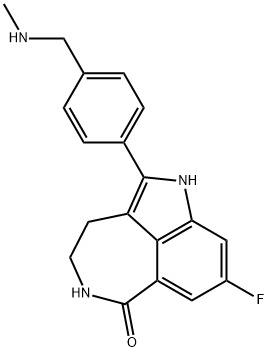
鲁卡帕尼
中文名称:
鲁卡帕尼
中文同义词:
瑞卡帕布碱;卢卡帕尼杂质;瑞卡帕布/鲁卡帕尼;鲁卡帕尼;卢卡帕尼;8-氟-1,3,4,5-四氢-2-[4-[(甲基氨基)甲基]苯基]-6H-吡咯并[4,3,2-EF][2]苯并氮杂卓-6-酮;8-氟-1,3,4,5-四氢-2-[4-[(甲基氨基)甲基]苯基]-6H-吡咯并[4,3,2-EF][2]苯并氮杂-6-酮;卢卡帕尼杂质16
英文名称:
Rucaparib
英文同义词:
8-FLUOR-2-{4-[(METHYLAMINO)METHYL]FENYL}-1,3,4,5-TETRAHYDRO-6HAZEPINO[5,4,3-CD]INDOOL-6-ON;8-fluoro-2-(4-((methylamino)methyl)phenyl)-4,5-dihydro-1H-azepino[5,4,3-cd]indol-6(3H)-one;6H-Pyrrolo[4,3,2-ef][2]benzazepin-6-one, 8-fluoro-1,3,4,5-tetrahydro-2-[4-[(methylamino)methyl]phenyl]-;AG 014447;AG 014447;AG014447;AG014447;Rikapbu;Rucaparib(AG-014447)
CAS号:
283173-50-2
分子式:
C19H18FN3O
分子量:
323.36
EINECS号:
814-445-0
相关类别:
抗肿瘤;原料药;医药原料
Mol文件:
283173-50-2.mol
沸点
625.2±55.0 °C(Predicted)
密度
1.281
储存条件
Keep in dark place,Sealed in dry,2-8°C
形态
Yellow solid.
酸度系数(pKa)
14.10±0.20(Predicted)
生物活性
Rucaparib (AG014699) 是一种具有口服活性的、有效的 PARP 抑制剂,对 PARP1 的 Ki 值为 1.4 nM,对其他八种 PARP 结构域也有亲和性。
靶点
PARP-1
1.4 nM (Ki)
PARP-1
1.4 nM (Ki)
体外研究
Rucaparib is the most potent PARP inhibitor in enzyme assays (K i , 1.4 nM), and a possible N-demethylation metabolite of AG14644. The radio-sensitization by Rucaparib is due to downstream inhibition of activation of NF-κB, and is independent of SSB repair inhibition. Rucaparib could target NF-κB activated by DNA damage and overcome toxicity observed with classical NF-κB inhibitors without compromising other vital inflammatory functions. Rucaparib inhibits PARP-1 activity by 97.1% at a concentration of 1 μM in permeabilised D283Med cells.
体内研究
Rucaparib and AG14584 significantly (P < 0.05) increases temozolomide toxicity. Rucaparib (1 mg/kg) significantly increases temozolomide-induced body weight loss. Rucaparib (0.1 mg/kg) results in a 50% increase in the temozolomide-induced tumor growth delay. Rucaparib is not toxic but significantly enhances temozolomide-induced TGD in the DNA repair protein-competent D384Med xenografts. Pharmacokinetics studies also show that Rucaparib is detected in the brain tissue, which indicates that Rucaparib has potential in intra-cranial malignancy therapy. Rucaparib significantly potentiates the cytotoxicity of topotecan and temozolomide in NB-1691, SH-SY-5Y, and SKNBE (2c) cells. Rucaparib enhances the antitumor activity of temozolomide and indicates complete and sustained tumor regression in NB1691 and SHSY5Y xenografts.








